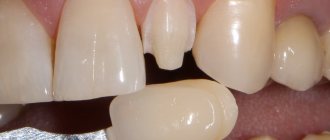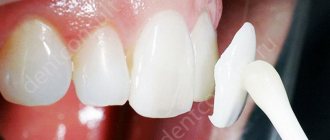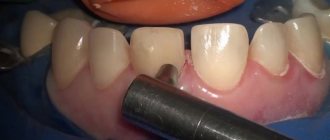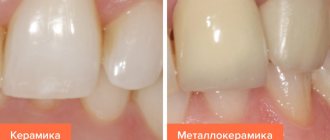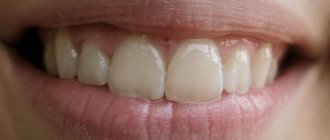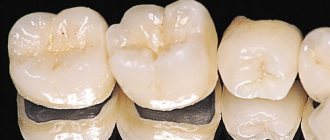What are temporary veneers, why get them and how long will you have to wear them?
Today, installing veneers that make a smile attractive is a procedure that is available to everyone. And almost a century ago, only Hollywood actors could afford them, and even then not for long - only for the period of time while filming took place. Celebrity stylists put thin plates on the teeth as a kind of make-up or disguise defects, and glued them with a temporary composition. After 1-2 days, such overlays were removed. Today, high-quality veneers that are installed in dental offices are permanent structures that serve their owners for 5-7 or more years (depending on the properties of the selected material). However, on the Internet you can find information about removable veneers. What are these structures? Find out more in our article today!
Indications
Veneers can be installed when minor defects are diagnosed. First of all, this applies to cracks and chips that appeared due to the abuse of solid products or after an injury. Also, overlays will be an excellent solution for darkening of the enamel after depulpation or congenital yellowness, which cannot be dealt with using classic bleaching. Previously installed fillings may have a different shade and differ from healthy teeth, and a thin ceramic plate will mask this defect.
They also allow you to eliminate malocclusions, that is, curvature and incorrect placement of individual units relative to each other. In order for a veneer to last a long time, absolutely all teeth must be present in the oral cavity. It is especially important that the chewing elements are preserved. Otherwise, the risk of plate destruction will be quite high due to the fact that the entire load will fall on them. The final decision on the advisability of installation is always made by the attending physician.
What are veneers
Veneers are very thin shells made of composite material, zirconium dioxide or ceramic. They are glued to the filed enamel surface with special cement in order to make the patient's front teeth ideal, i.e. hide all external cosmetic defects and imperfections: chips, cracks, unsightly shade, fillings, diastema, slight curvature.
Read more about what veneers are in a specially prepared article on the website.
This orthopedic solution has its pros and cons. For example, its advantages include high aesthetic results and low trauma during installation compared to crowns. And among the disadvantages is a fairly high price. Also, do not forget that grinding the enamel before installing veneers is still necessary, and this process is irreversible, because After removal, the teeth will no longer look the same as before.
How to put veneers on crooked teeth
Considering that veneering is a purely cosmetic service, that is, it cannot cure or straighten uneven teeth. Veneers can be applied to one or two crooked front teeth. Mask wide interdental spaces and align the line of the dentition.
When is the installation of a microprosthesis contraindicated?
Veneers cannot be placed
on the front teeth in the following cases:
- If there is a pathological curvature of the teeth in a large group (one tooth overlaps another).
- Incorrectly developed bite due to any diseases, poor nutrition or hygiene.
To correct pathological defects, other orthopedic and orthodontic methods are used, in particular wearing braces.
What are removable veneers and what are they for?
These are temporary overlays or caps made of plastic that the doctor installs on the teeth after preparing the enamel and taking impressions. The fact is that permanent veneers still need to be made in a dental laboratory so that they recreate the anatomy of the patient’s natural teeth as accurately as possible and look natural. The production of onlays can take from 1 week to a month, it all depends on the workload of the laboratory. During this period of time, the ground enamel does not look very aesthetically pleasing, and without temporary overlays it will also remain defenseless against external influences: bacteria, plaque, temperature and hardness of food.
To protect the ground enamel, doctors resort to the use of removable veneers. The plates are made of plastic and attached with glue, which, however, can be easily removed in the dental office. Such onlays allow you to protect your teeth while the patient is waiting for a follow-up appointment with the orthopedist.
What are implants: features of treatment protocols
So, if you have no teeth at all, veneers are not suitable. Alternative options are removable dentures or implants. Implantation is beneficial for many indications, especially when the patient is completely edentulous.
An implant in dentistry is a multicomponent structure that includes:
- A pin is an implant itself that is implanted into the patient’s bone tissue and acts as a “root” for an artificial tooth. The pin is made from pure medical titanium or a titanium alloy that can integrate into the bone and become part of the bone structure of the jaw.
- An abutment is an adapter responsible for attaching the crown to the titanium pin of the implant. Has different sizes and shapes. Selected by the dentist for a specific type of implant.
- An artificial tooth is a crown made of metal ceramics or zirconium dioxide that can replace a tooth not only externally, but also take over its chewing functions.
When veneers are not possible due to a patient missing one or more units, implants are an excellent choice. Their main advantage is the ability to withstand loads similar to living teeth and create the necessary physiological pressure on bone tissue.
For complete edentia, all-on-4 and all-on-6 implantation protocols are indicated, in which a fixed prosthesis is placed on 4 or 6 implants immediately after the implantation of the pins. The prosthesis completely duplicates the patient's jaw being replaced. This type of implantation is also called one-stage implantation.
Perfect Smile overlay veneers
By removable veneers, dentists mean temporary overlays that protect the patient’s teeth from external influences for that period of time until permanent ones are made. However, today on the Internet you can find offers from various online stores in which users are told about the advantages of inexpensive overlay veneers. For example, Perfect Smile from the USA. Manufacturers claim that this miracle product allows you to achieve an ideal snow-white smile for a while and does not require you to make any sacrifices at all, i.e. allow you to do without grinding the enamel.
But let’s look at their main advantages from the manufacturer’s point of view, and then the disadvantages from the point of view of deceived buyers who have already fallen for the tricks of marketers advertising this product and many beautiful pictures. We will also find out the opinion of professional dentists on this matter.
The manufacturer claims that such devices are universal and are suitable for absolutely all people who need to look irresistible at some event (wedding, business meeting, photo and video shooting). The essence of this method is simple: temporary products are put on the teeth like a mouthguard, and are held securely due to the chemical properties of the material.
To use these veneers, you need to heat them in boiling water for a few minutes, then remove them using a clean cutlery, let them cool slightly and place them tightly on the upper or lower teeth. This is done so that the inside of the veneers adapts to the individual structure of the dentition. After which the pad is removed and placed in a glass of cold water. After the outer side of the veneers turns snow-white, they are placed on the teeth and worn.
Important! Although temptingly cheap, such overlay plates have several significant drawbacks. For example, they do not have an individual design, they do not take into account the structure of the oral cavity, which means they may be uncomfortable to wear. Besides, they look unnatural. In addition, they have to be removed before each meal, otherwise they quickly become unusable.
It would seem that in the head of someone who is going to buy overlays, an ideal image is created. However, in reality everything turns out to be not so beautiful. Plastic or propylene products that people received by mail, after placing them in boiling water, immediately stuck to their teeth, but as soon as they cooled down, they instantly fell off, i.e. They don't stay in the mouth at all. Users also note that they have an unpleasant taste and smell of plastic, like any cheap Chinese product. Plus, the onlays did not fit the size of the teeth, because, of course, they are templates, and at the same time they are not made in a jewelry manner.
Dentists and orthopedists are of the same opinion: if you want to solve dental problems, go to a professional doctor, and do not buy masquerade toys that have a dubious composition. Not only will they not make your smile attractive, but they can also negatively affect your health, because no one rules out the toxicity of the material from which these products are made. In addition, you need to use common sense and understand that pads that are fixed to the water are nonsense.
How removable veneers are made and applied
Since the installation of temporary plates is one of the stages of prosthetics, they are made on the basis of the same impression that is made for turning permanent dentures. This allows you to create a product based on an individual layout, as well as correct shortcomings that are revealed during the installation of temporary veneers.
On a note! Sometimes on the Internet you can find information that composite veneers are called removable, which the doctor can install on the teeth in just one visit through layer-by-layer application of the composite, and, if necessary, also quickly remove or make corrections. However, in relation to composite onlays, terms such as “removable” or “temporary” cannot be used, because With careful care they can last 3-5 years.
To attach the plates, the doctor uses special cement, which will provide strong adhesion and protection from thermal effects, but can be easily removed from the tooth by the dentist.
Veneers for uneven teeth - step-by-step installation process
Initial appointment
– inspection of the problem area. And if there are no reasons for contraindications, I conduct a visual diagnosis of the oral cavity.
If any inflammatory processes are detected in the gums or teeth, I prescribe laboratory diagnostics followed by sanitation of the oral cavity. You cannot install veneers if there is any pathology of the dental system.
At the first visit, the patient selects the material for making the nozzle, using a special scale, and the shade is selected.
Second phase
consists of grinding the teeth to be veneered. The orthopedist himself determines which layer of dental tissue should be removed. An impression of the tooth is made and sent to a dental technician, who within a week will make an exact copy of the impression from the ordered material.
While the veneer is being made, the patient is given temporary plastic veneers.
- pads.
Final stage
– placement of veneers on prepared teeth.

